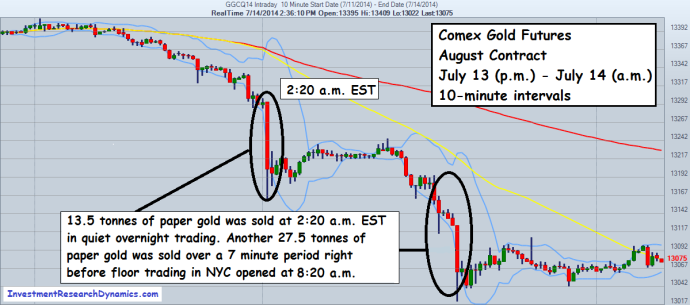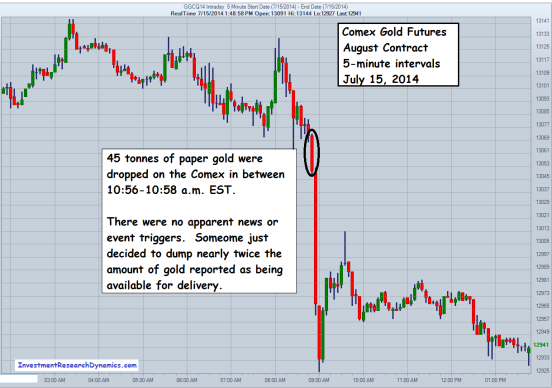Insider Trading and Financial Terrorism on Comex
 Print This Article
Print This Article
Paul Craig Roberts and Dave Kranzler
July 16, 2014. The first two days this week gold was subjected to a series of computer HFT-driven “flash crashes” that were aimed at cooling off the big move higher gold has made since the beginning of June. During this move higher, the hedge funds, who typically “chase” the momentum of gold up or down, built up hefty long positions in gold futures over the last 6 weeks. In order to disrupt the upward momentum in the price of gold, the bullion banks short gold in the futures market by dumping large contracts that drive down the price and make money for the banks in the process.
As we explained in previous articles on this subject, the price of gold is not determined in markets where physical gold is bought and sold but in the paper futures market where contracts trade and speculators place bets on the price of gold. Most of the contracts traded on the Comex futures market are settled in cash. The value of the contracts used to short gold and drive down the price is well in excess of the actual amount of physical gold that is kept on the Comex and available for delivery. One might think that regulators would pay attention to a market in which the value of contracts outstanding exceeds by several multiples the amount of physical gold available for delivery.
The Comex gold futures market trades 23 hours per day on a global computer system called Globex and on the NYC trading floor from 8:20 a.m. EST to 1:30p.m. EST. The Comex floor trading session is the highest volume trading period during any 23 hour trading period because that is when most of the large U.S. financial institutions and other users of Comex futures (jewelry manufactures and gold mining companies) are open for business and therefore transact their Comex business during Comex floor hours in order to achieve the best trading execution at the lowest cost.
The big hedge funds primarily trade gold futures using computers and algorithm programs. When they buy, they set stop-loss orders which are used to protect their trading positions on the downside. A “stop-loss” order is an order to sell at a pre-specified price by a trader. A stop-loss order is automatically triggered and the position is sold when the market trades at the price which was pre-set with the stop-order.
The bullion banks who are members and directors of Comex have access to the computers used to clear Comex trades, which means they can see where the stop-loss orders are set. When they decide to short the market, they start selling Comex futures in large amounts to force the market low enough to trigger the stop-loss orders being used by the hedge fund computers. For instance, huge short-sell orders at 2:20 a.m. Monday morning triggered an avalanche of stop-loss selling, as shown in this graph of Monday’s (July 14) action (click on graph to enlarge):
In the graph above, the first circled red bar shows the flash crash that was engineered at 2:20 a.m. EST, a typically low-volume, quiet period for gold trading. 13.5 tonnes of short-sales were unloaded into the Comex computer trading system. The second circled red bar shows a second engineered flash-crash right before the Comex floor opened at 8:20 a.m. EST. This was triggered by sales of futures contracts representing 27.5 tonnes of gold. A third hit (not shown) occurred at 9:01 a.m. This time contracts representing 40 tonnes of gold hit the market.
The banks use the selling from the hedge funds to cover the short positions they’ve amassed and book trading profits as they cover their short positions at price levels that are below the prices at which their short positions were established. This is insider trading and unrestrained financial terrorism at its finest.
As shown on the graph below, on Tuesday, July 15, another flash-crash in gold was engineered in the middle of Janet Yellen’s very “dovish” Humphrey-Hawkins testimony. Contracts representing 45 tonnes of gold were sold in 3 minutes, which took gold down over $13 and below the key $1300 price level. There were no apparent news triggers or specific comments from Yellen that would have triggered a sudden sell-off in gold — just a massive dumping of gold futures contracts. No other related market (stocks, commodities) registered any unusual movement up or down when this occurred:
Between July 14 and July 15, contracts representing 126 tonnes of gold was sold in a 14-minute time window which took the price of gold down $43 dollars. No other market showed any unusual or extraordinary movement during this period.
To put contracts for 126 tonnes of gold into perspective, the Comex is currently reporting that 27 tonnes of actual physical gold are classified as being available for deliver should the buyers of futures contracts want delivery. But the buyers are the banks themselves who won’t be taking delivery.
One motive of the manipulation is to operate and control Comex trading in a manner that helps the Fed contain the price of gold, thereby preventing its rise from signaling to the markets that problems festering in the U.S. financial system are growing worse by the day. This is an act of financial terrorism supported by federal regulatory authorities. Another motive is to help support the relative trading level of the U.S. dollar, as we’ve described in previous articles on this topic. And, of course, the banks make money from the manipulation of the futures market.
The Commodity Futures Trading Commission, the branch of government which was established to oversee the Comex and enforce long-established trading regulations, has been presented with the evidence of manipulation several times. Its near-automatic response is to disregard the evidence and look the other way. The only explanation for this is that the Government is complicit in the price suppression and manipulation of gold and silver and welcomes the insider trading that helps to achieve this result. The conclusion is inescapable: if illegality benefits the machinations of the US government, the US government is all for illegality.
Dave Kranzler has years of experience in financial markets and spent 15 years on Wall Street. His site is www.investmentresearchdynamics.com
-
Biden: White Americans Are the Threat
-
America: Goodbye my Country
-
“War Is a Racket” — US Marine General Smedley D. Butler
-
Justice (sic) Department Conspired with Biden, FBI, National Archives, and NY Times to Concoct a “Documents Case” against Trump
-
Tucker Carlson Explains that Watergate Was an Orchestration to Remove President Nixon from Office
-
Fighting to the Last Ukrainian
-
The Real Debt Problem
-
“Israel is a lunatic state”
-
The Whore Media, Like “Our” Government, Always Misleads
-
Texas Is a Fading Conservative State
-
This is what the digital revolution brought us
-
The Great Dispossession Part 4
-
Republican Speaker of the House Flushes US Constitution Down the Toilet
-
Texas Is Being Turned Into a Woke Democrat State
-
Democrat Prosecutors, Judges, and Media Are Interfering in the November Presidential Election
-
Are We Witnessing a Tempering of American-Israeli Aggression?
-
Breaking News– As I expected, the war has begun
-
The Great Dispossession Part 3
-
America Is No Longer a Merit-based Society
-
Is Putin Responsible for Israel’s April 1 Attack on Damascus, Syria, that Killed 7 officers of the Islamic Revolutionary Guard?
-
The Great Dispossession Part 2
-
Putin Continues to Conduct His War in a Reactive Way
-
Democrats Respond to Trump’s Plea to Kill Police State FISA Act
-
The Great Dispossession Part 1
-
Putin Has Allowed the Ukraine Conflict to Spiral Out of Control
-
America Has a Third World Economy
-
24/7 Media and No Valid Information
-
Facing Nuclear War
-
Ivermectin Emerges as a Significant Aid in Cancer Treatment
-
Putin’s Road to Armageddon
-
A New Russia Has Emerged
-
The Termination of Christian Celebration
-
The New York City Council No Longer Differentiates Between Illegal Aliens and US Citizens
-
The Russian Federal Security Service Identifies US as a Suspect in Crocus Attack
-
Washington Crossed a Fatal Red Line with the Crocus Attack
-
How Private Interests Seized Control of America
-
The Most Astounding Feature of the Assange Case
-
The US and Europe Have Given Their Countries to Immigrant-invaders
-
Dmitry Trenin Belatedly Realizes that Putin Has Not Been Sufficiently Proactive to Prevent Nuclear War
-
A Tower of Babel Is a Country Without a Language
-
DEI Is White Genocide
-
Whatever Happened to Conservatives?
-
Washington Post Calls on VP Kamala Harris to Step Down
-
Thank you for your support
-
Russia — A Democracy that Works
-
EMPIRE OF LIES
-
The Ever Widening War
-
The Alleged superpower, USA, No Longer Has a Military
-
John Grisham Finds Justice Not in the System, but in the System’s Defeat
-
US Navy Medic Shut Down for Releasing unclassified DOD Data Showing a 937% Increase in Heart Failure Among Vaccinated US Military Personnel


